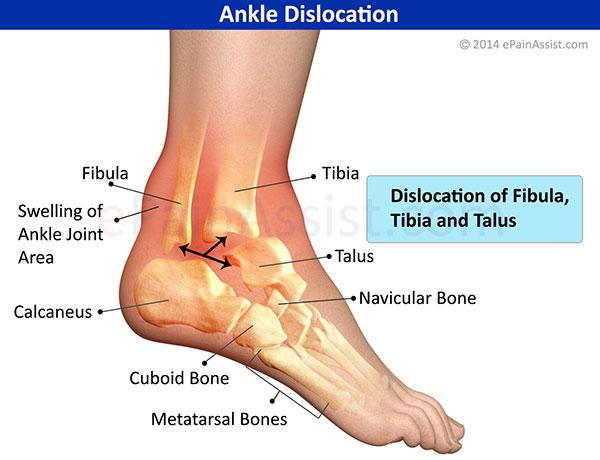A dislocated ankle is a serious condition characterized by the displacement of the bones that form the ankle joint, resulting in damage and tearing of the connective tissue surrounding the joint. In a dislocation, the bones are no longer positioned next to each other, leading to instability and significant pain.
Anatomy of the Ankle Joint
The ankle joint is composed of:
- Joint Capsule: A strong connective tissue that encases the joint, providing stability.
- Ligaments: Several ligaments help secure the bones together and prevent excessive movement.
- Muscles: Numerous muscles surrounding the ankle add further support and stability.
Due to the significant forces required to dislocate the ankle, this injury often occurs in combination with other injuries to the foot, ankle, or lower leg, such as fractures or severe (Grade III) ankle sprains.
Causes of Ankle Dislocation
Dislocated ankles typically result from traumatic events that push the ankle bones apart. Common causes include:
- Direct Impact: A fall or collision that exerts force on the ankle.
- Motor Vehicle Accidents: High-energy impact can lead to dislocation.
- Severe Ankle Sprains: Ankle rolling excessively during activities can lead to dislocation.
- Sports Injuries: Ankle dislocations are frequently seen in sports that involve rapid changes of direction, such as rugby, soccer, basketball, netball, and football.
Symptoms of a Dislocated Ankle
Patients with a dislocated ankle typically experience:
- Sudden Severe Pain: The pain is often immediate and intense, preventing the individual from continuing the activity. Patients may limp or be unable to bear weight.
- Localized Pain: While the pain is primarily in the ankle area, it can occasionally radiate into the foot, lower leg, or calf.
- Sensation of Movement: Many individuals report feeling as though their ankle “moved out” at the time of injury.
- Swelling and Deformity: Swelling around the ankle is common, and a visible deformity may be evident when comparing it to the other ankle. Bruising may also appear and worsen over time.
- Increased Pain on Touch: The affected area becomes tender, and pain usually intensifies with pressure on the ankle joint.
Seeking Treatment
A dislocated ankle is a medical emergency that requires prompt evaluation and treatment. If you suspect that you or someone else has a dislocated ankle, it’s essential to seek medical attention immediately. Delaying treatment can lead to complications, including chronic instability, arthritis, or damage to surrounding tissues and nerves.
Conclusion
If you’re experiencing foot or ankle pain or trauma, don’t hesitate to reach out for medical help. At Southern Maryland Foot & Ankle, our experienced team is here to provide comprehensive evaluation and treatment for dislocated ankles and other foot and ankle injuries.
To schedule your appointment or to learn more about our services, contact our Waldorf or Clinton office today at (301) 868-3899 or (301) 843-9581. Don’t let an ankle injury sideline you—take the first step towards recovery today!

